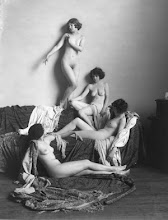From Ways of Seeing by John Berger:
...the social presence of a woman is different in kind from that of a man. A man's presence is dependent upon the promise of power which he embodies...its object is always exterior to the man....
By contrast, a woman's presence expresses her own attitude to herself, and defines what can and cannot be done to her. Her presence is manifest in her gestures, voice, opinions, expressions, clothes...indeed, there is nothing she can do which does not contribute to her presence...
A woman must continually watch herself. She is almost continually accompanied by her own image of herself. Whilst she is walking across a room or whilst she is weeping at the death of her father, she can scarcely avoid envisaging herself walking or weeping....She has to survey everything she is and everything she does because how she appears to others, and ultimately how she appears to men, is of crucial importance for what is normally thought of as the success of her life. Her own sense of being in herself is supplanted by a sense of being appreciated as herself by another.
I hadn't read this book before. This morning, I found it on the shelf while looking randomly at things, which is sometimes helpful when you're stuck. You never know when you'll pull a book off a shelf, see a guillotine illustrated and think, "I know! My scene needs a guillotine!" And the quotation above (there's a lot more to it than that) reminded me of what I'm working on.
It also reminded me of a 1916 book on film theory which is concerned with what this brand-new iteration of "seeing" meant to the world. The argument in that book was that audiences identify so completely with actors on film that even in moments where a stunt double has taken their places, we don't notice, or don't want to notice the substitution, because we have become part of what we're surveying. We don't want to be jarred out of it by recognizing bad edits, illogical leaps, and most importantly new actors taking the place of old. There is some link that I don't yet understand between those two ideas: film theory and Berger's observations on "presence." I think it has to do with movie stars.
Added: one ghost. This is either a good idea or a bad one.





No comments:
Post a Comment